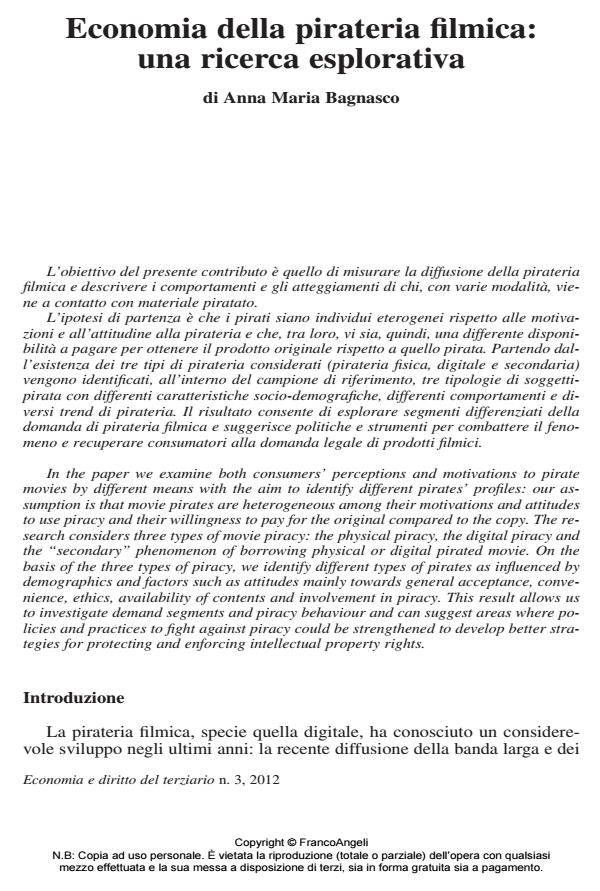Economia della pirateria filmica: una ricerca esplorativa
Journal title ECONOMIA E DIRITTO DEL TERZIARIO
Author/s Anna Maria Bagnasco
Publishing Year 2013 Issue 2012/3 Language Italian
Pages 16 P. 433-448 File size 491 KB
DOI 10.3280/ED2012-003006
DOI is like a bar code for intellectual property: to have more infomation
click here
Below, you can see the article first page
If you want to buy this article in PDF format, you can do it, following the instructions to buy download credits

FrancoAngeli is member of Publishers International Linking Association, Inc (PILA), a not-for-profit association which run the CrossRef service enabling links to and from online scholarly content.
In the paper we examine both consumers’ perceptions and motivations to pirate movies by different means with the aim to identify different pirates’ profiles: our assumption is that movie pirates are heterogeneous among their motivations and attitudes to use piracy and their willingness to pay for the original compared to the copy. The research considers three types of movie piracy: the physical piracy, the digital piracy and the "secondary" phenomenon of borrowing physical or digital pirated movie. On the basis of the three types of piracy, we identify different types of pirates as influenced by demographics and factors such as attitudes mainly towards general acceptance, convenience, ethics, availability of contents and involvement in piracy. This result allows us to investigate demand segments and piracy behaviour and can suggest areas where policies and practices to fight against piracy could be strengthened to develop better strategies for protecting and enforcing intellectual property rights.
- Anderson, C., The Long Tail, Wired, October 2004. http://www.wired.com/wired/archive/ 12.10/tail.html
- Balestrino, A., It is a theft but not a crime, in «European Journal of Political Economy », 2008, 24 (2), pp. 455-469
- BASCAP, Research Report on Consumer Attitudes and Perceptions on Counterfeiting and Piracy, 2009. http://www.iccwbo.org/uploadedFiles/BASCAP/Pages/BASCAPConsumer% 20Research%20Report_Final.pdf.
- Belleflamme, P., Peitz, M., Digital Piracy: Theory, in Peitz, M., Waldfogel, J. (eds.), The Oxford Handbook of the Digital Economy, Oxford University Press, 2011
- Bounie, D., Waelbroeck, P., Bourreau, M., Piracy and the Demand for Films: Analysis of Piracy Behavior in French Universities, in «Review of Economic Research on Copyright Issues», 2006, 3, pp. 15-27, 2006.
- Brynjolfsson, E., Hu, Y.J., Smith, M. D., From Niches to Riches: Anatomy of the Long Tail, in «Sloan Management Review», 2006, 47, pp. 67-71.
- Cook, D.A., Wang, W., Neutralizing the piracy of motion pictures: Reengineering the industry’s supply chain, in «Technology in Society», 2004, 26, pp. 567-583. DOI: 10.1016/j.techsoc.2004.08.001
- Danaher, B., Dhanasobhon, S., Smith, M.D., Telang R., Converting Pirates without Cannibalizing Purchasers: The Impact of Digital Distribution on Physical Sales and Internet Piracy, in «Marketing Science», 2010, pp. 1138-1151. DOI: 10.1287/mksc.1100.0600.
- Das, S., Timing movie release on the Internet in the context of piracy, «Journal of Organizational Computing and Electronic Commerce», 2008, 18 (4), pp. 307-332. DOI: 10.1080/10919390802421283
- De Vany, A.S., Walls, D.W., Estimating the effects of movie piracy on Box-office revenue, in «Review of Industrial Organisation», 2007, 30, pp. 291-301.
- FAPAV-IPSOS, La pirateria video in Italia, 2009.
- IFPI, Digital music report. Expanding choise. Going global, 2012. http://www.ifpi.org/content/ library/DMR2012.pdf
- Hennig-Thurau, T., Henning, V., Sattler H., Eggers, F., Houston, M. B., The Last Picture Show? Timing and Order of Movie Distribution Channels, in «Journal of Marketing», 2007a, 71, pp. 63-83. DOI: 10.1509/jmkg.71.4.63
- Hennig-Thurau, T., Henning, V., Sattler, H., Consumer File Sharing of Motion Pictures, in «Journal of Marketing», 2007b, 71, pp. 1-18. DOI: 10.1509/jmkg.71.4.1
- Holm, H.J., Can Economic Theory Explain Piracy Behavior?, in «Topics in Economic Analysis & Policy», 2003, 3, pp. 1-15. DOI: 10.2202/1538-0653.1082
- Huygen, A., Natali, H., Poort J., Rutten, P., van Eijk, N., Ups and downs. Economic and Cultural Effects of File Sharing on Music, Film and Games, TNO Information and Communication Technology Series, 2009. http://www.internationalchamberofcommerce. org/uploadedFiles/BASCAP/Pages/Ups%20and%20Downs.pdf.
- Khouja, M., Rajagopalan, H. K., Can piracy lead to higher prices in the music and motion picture industries?, in «Journal of the Operational Research Society», 2009, 60, pp. 372-383. DOI: 10.1057/polgrave.jors.2602552
- Liebowitz, S.J., File Sharing: Creative Destruction or Just Plain Destruction?, in «Journal of Law and Economics», 2006, 49, pp. 1-28. DOI: 10.1086/503518
- Mandel, P., Sussmuth, B., Digital Piracy in Europe: Some first micro-evidence based on a German survey, 2009, Munich University of Technology. http://www.serci.org/2009/DP_MS.pdf
- Martikainen, E., Does file-sharing reduce DVD sales?, 2010, http://taloustiede.utu.fi/henkilokunta/ henkilokunta/martikainen/MartikainenDVDpaper2010.pdf.
- Oberholzer-Gee, F., Strumpf, K., File-Sharing and Copyright, in Lerner J., Stern S. (eds), NBER Book Series Innovation Policy and the Economy, Vol. 10, pp. 19-55, 2010. http://www.nber.org/chapters/c11764.pdf.
- OECD, OECD Information Technolohy Outlook 2008, OECD Publishing, 2009
- Oxford Economics, Economic impact of legislative reform to reduce audio-visual piracy. Final Report, 2009. http://www.allianceagainstiptheft.co.uk/downloads/reports/ Great%20Expectations%20Economic%20impact%20.pdf.
- Oxford Economics, Ipsos MediaCT, Economic consequences of movie piracy, Canada Report, 2011 http://www.scribd.com/doc/52258548/IPSOS-OXFORD-ECONOMICS- Report-February-17-2011.
- Peitz, M., Waelbroek, P., Piracy of Digital Products: A Critical Review of the Theoretical Literature, in «Information Economics & Policy», 2006, 18, pp. 449-476. DOI: 10.1016/j.infoecopol.2006.06.005
- Pitkar, K., Rajpathak, S., Motwani, T., Mahendiran, A., Minimizing Revenue Loss Due to Piracy: An Early Internet Release of Motion Picture, University of Colorado, Boulder, 2008. https://drachma.colorado.edu/dspace/bitstream/123456789/276/1/Digikast.pdf.
- Siwek S.E., The True Cost of Copyright Industry Piracy to the U.S. Economy, Policy Report 189, IPI Center for Economic Growth, 2007. http://www.ipi.org/IPI%5CIPIPublications. nsf/PublicationLookupMain/A2C29ADF66FD941186257369005A052 D.
- Smith, M., Telang, R., Competing with Free: The Impact of Movie Broadcasts on DVD Sales and Internet Piracy, in «Management Information Systems Quarterly», 2009, 33, pp. 312-338
- UK Film Council, Film theft in the UK Anti-Piracy Task Force: an analysis and recommendations for action London, 2004. www.ukfilmcouncil.org.uk/media/pdf/j/4/ Film_theft_in_the_UK.pdf
- van Eijk, N., Poort, J., Rutten, P., Legal, Economic and Cultural Aspects of File Sharing, in «Communications & Strategies»,77, 1st Q., p.35, 2010. http://www.ivir.nl/publications/vaneijk/Communications&Strategies_2010.pdf.
Anna Maria Bagnasco, Economia della pirateria filmica: una ricerca esplorativa in "ECONOMIA E DIRITTO DEL TERZIARIO " 3/2012, pp 433-448, DOI: 10.3280/ED2012-003006